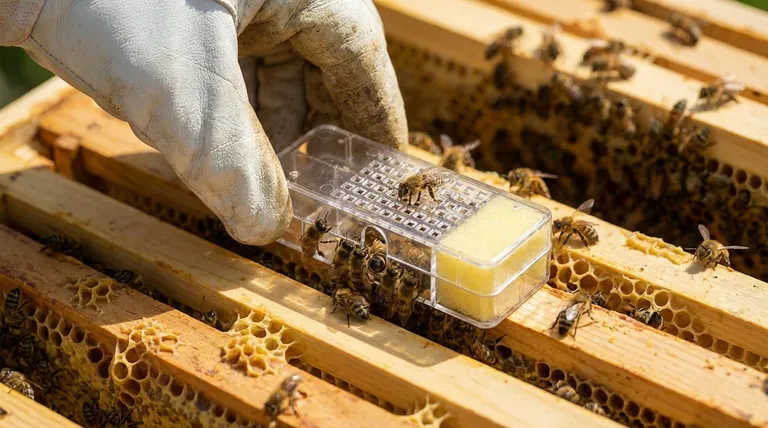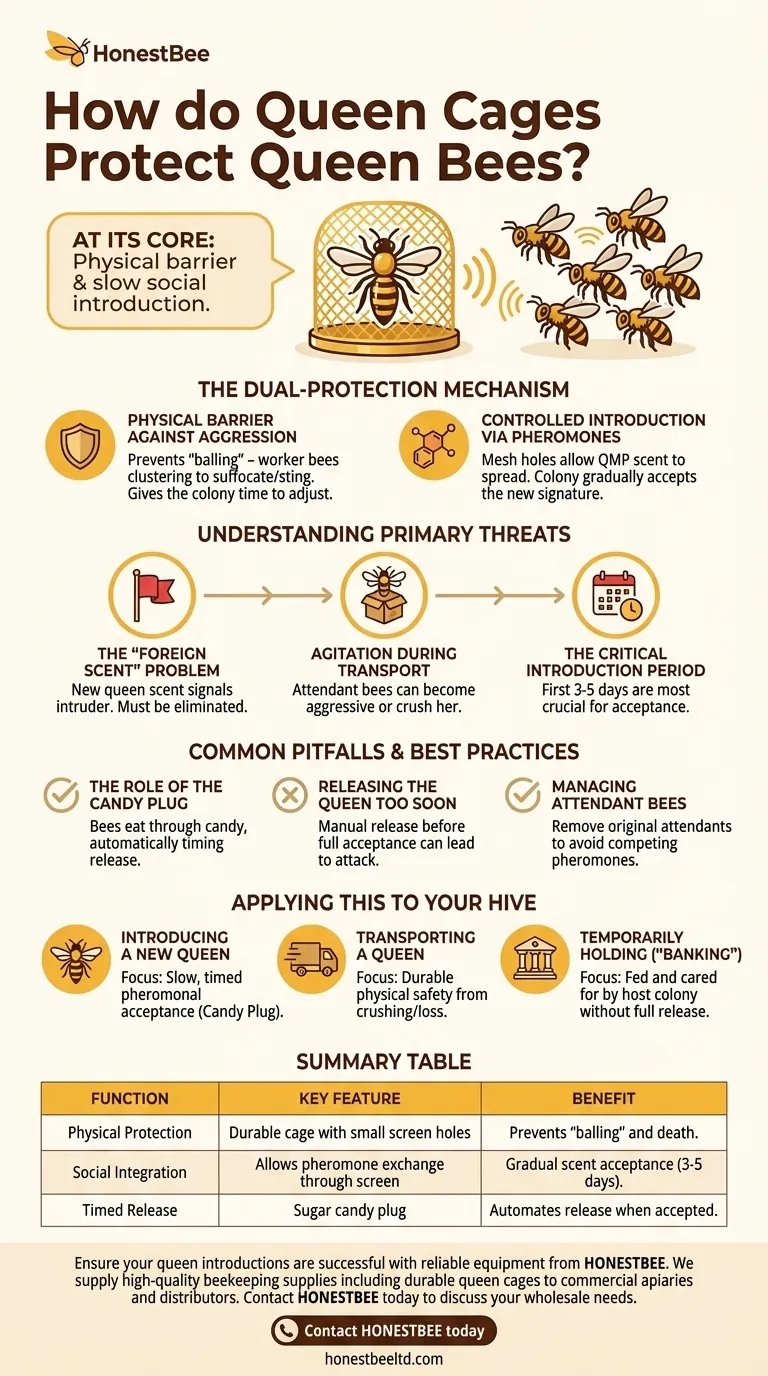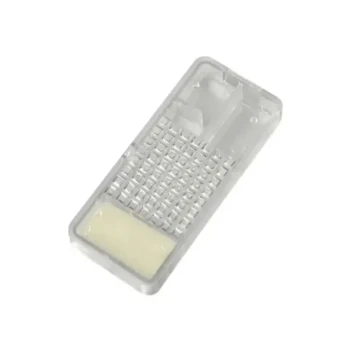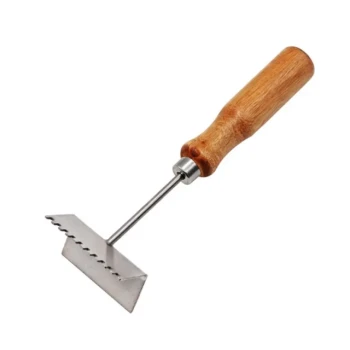At its core, a queen cage protects a queen bee by creating a physical barrier that separates her from the other bees in a colony. This cage, typically made of plastic or metal, features small openings that are large enough for worker bees to feed the queen and interact with her antennae, but too small for them to get inside and harm her.
The primary function of a queen cage is not just physical protection, but facilitating a slow, controlled social introduction. It allows the new queen's unique pheromones to spread throughout the hive, ensuring the colony accepts her scent and identity before she is fully released.

The Dual-Protection Mechanism
A queen cage functions on two levels: physical security and social integration. Both are critical for successfully introducing a new queen to a hive that sees her as a foreign intruder.
Physical Barrier Against Aggression
A colony's first instinct when encountering an unknown queen is often to kill her. This defensive reaction, known as "balling," involves worker bees clustering tightly around the queen to suffocate or sting her to death.
The cage provides an impenetrable shield against this immediate threat, giving the colony time to adjust.
Controlled Introduction via Pheromones
The small holes in the cage are its most sophisticated feature. As worker bees make contact through the screen, they pick up the queen's unique queen mandibular pheromone (QMP).
They then spread this scent throughout the hive as they interact with other bees. Over several days, the entire colony gradually becomes familiar with and accepts this new pheromone signature as their own.
Understanding the Primary Threats
A queen requires protection because she is both the most important and most vulnerable member of a new colony.
The "Foreign Scent" Problem
Bees operate on a complex system of chemical communication. A new queen's scent is an immediate red flag, signaling an intruder that must be eliminated to protect the existing (or recently lost) queen's lineage.
Agitation During Transport
Queen cages are also used for shipping. The attendant bees packaged with the queen can become stressed and aggressive during transit. The cage ensures the queen remains safe from them and from being crushed.
The Critical Introduction Period
Protection is most crucial during the first 3-5 days after placing a queen in a new hive. This period is when the colony decides whether to accept or reject her, making the cage's slow-release function essential.
Common Pitfalls and Best Practices
Using a queen cage correctly is as important as the cage itself. Simple mistakes can lead to the rejection and death of a valuable queen.
Releasing the Queen Too Soon
Manually releasing a queen before the colony has fully accepted her scent is a common failure point. The bees may appear calm but can turn on her moments after she is free.
The Role of the Candy Plug
Most modern queen cages have a tube filled with a sugar candy. After placing the cage in the hive, the beekeeper removes a cork, exposing the candy. The bees on both sides of the cage slowly eat through the candy, which automatically times the queen's release for a point when she has likely been accepted.
Managing Attendant Bees
Some beekeepers prefer to remove the attendant bees that are shipped with the queen before introducing her to the hive. This ensures no competing pheromones from her original hive confuse the introduction process.
Applying This to Your Hive
Your approach to using a queen cage should align with your specific beekeeping goal.
- If your primary focus is introducing a new queen: Rely on the candy plug for a slow, timed release, as this allows for pheromonal acceptance.
- If your primary focus is transporting a queen: The cage serves as a durable container that ensures her physical safety from being crushed or lost.
- If your primary focus is temporarily holding a queen ("banking"): The cage allows her to be fed and cared for by a host colony without being fully released and integrated.
Ultimately, a queen cage is a simple but powerful tool for managing the complex social dynamics of a honey bee colony.
Summary Table:
| Function | Key Feature | Benefit |
|---|---|---|
| Physical Protection | Durable cage with small screen holes | Prevents worker bees from 'balling' and killing the new queen. |
| Social Integration | Allows pheromone exchange through screen | Lets the colony gradually accept the queen's scent over 3-5 days. |
| Timed Release | Sugar candy plug | Automates the queen's release once the colony is likely to accept her. |
Ensure your queen introductions are successful with reliable equipment from HONESTBEE.
We supply high-quality beekeeping supplies and equipment, including durable queen cages, to commercial apiaries and beekeeping equipment distributors through our wholesale-focused operations. Protect your valuable queens and ensure smooth hive integrations.
Contact HONESTBEE today to discuss your wholesale needs and enhance your beekeeping operations.
Visual Guide

Related Products
- Professional Queen Bee Introduction and Transport Cage
- Durable Galvanized Steel Spring Queen Bee Cage
- No Grafting Queen Rearing Kit: System for Royal Jelly Production and Queen Rearing
- Jenter Queen Rearing Kit Complete Set for Bee Breeding
- Nicot Queen Rearing Kit for Beekeeping and Grafting in Nicot System
People Also Ask
- Why is it important to monitor bees after relocation? Essential Guide for Apiary Success
- What are the advantages of using a nuc box? Achieve Superior Colony Management and Growth
- What are the common sizes and types of nuc boxes? A Guide to the Perfect Fit for Your Apiary
- How are mating boxes set up for queen rearing? A Guide to Building a Stable Nucleus Colony
- What is a baby nuc or mating nuc used for? A Guide to Efficient Queen Rearing



















